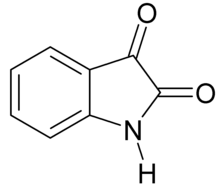Isatin

| |
| Names | |
|---|---|
| IUPAC name
1H-indole-2,3-dione
| |
| Identifiers | |
3D model (JSmol)
|
|
| ChEBI | |
| ChEMBL | |
| ChemSpider | |
| DrugBank | |
| ECHA InfoCard | 100.001.889 |
| KEGG | |
CompTox Dashboard (EPA)
|
|
| |
| |
| Properties | |
| C8H5NO2 | |
| Molar mass | 147.1308 g/mol |
| Appearance | Orange-red solid |
| Melting point | 200 °C (392 °F; 473 K) |
Except where otherwise noted, data are given for materials in their standard state (at 25 °C [77 °F], 100 kPa).
| |
Isatin or 1H-indole-2,3-dione is an indole derivative. The compound was first obtained by Erdmann[1] and Laurent[2] in 1841 as a product from the oxidation of indigo dye by nitric acid and chromic acids. The compound is found in many plants, such as Isatis tinctoria, Calanthe discolor and in Couroupita guianensis.[3]
Schiff bases of isatin are investigated for their pharmaceutical properties.[4]
Isatin forms a blue dye (indophenin) if it is mixed with sulfuric acid and crude benzene. The formation of the indophenin was long believed to be a reaction with benzene. Victor Meyer was able to isolate the substance responsible for this reaction from crude benzene. This new heterocyclic compound was thiophene.[5]
Preparation
Isatin is commercially available. It may be prepared from cyclicizing the condensation product of chloral hydrate, aniline and hydroxylamine in sulfuric acid. This reaction is called the Sandmeyer isonitrosoacetanilide Isatin Synthesis and was discovered by Traugott Sandmeyer in 1919:[6][7]
Another classic reaction, the Sandmeyer diphenylurea isatin synthesis (Sandmeyer 1903), starts from diphenylthiourea, potassium cyanide, and lead carbonate.[8]
Isatins can be made from the corresponding indole in good yield by a mix of InCl3 and IBX in an acetonitrile-water solution at 80°C.[9]
References
- ^ Erdmann, O. L. (1840). "Untersuchungen über den Indigo". Journal für Praktische Chemie. 19 (1): 321–362. doi:10.1002/prac.18400190161.
- ^ Laurent, A. (1840). "Recherches sur l'indigo". Annales de Chimie et de Physique. 3 (3): 393–434.
- ^ da Silva, J. F. M.; Garden, S. J.; Pinto, A. C. (2001). "The Chemistry of Isatins: a Review from 1975 to 1999" (pdf). Journal of the Brazilian Chemical Society. 12 (3): 273–324. doi:10.1590/S0103-50532001000300002.
{{cite journal}}: CS1 maint: multiple names: authors list (link) - ^ Jarrahpour, A. A.; Khalili, D. (2005). "Synthesis of 3,3´-[methylenebis(3,1-phenylenenitrilo)]bis[1,3-dihydro]-2H-indol-2-one as a Novel bis-Schiff Base" (pdf). Molbank. 2005 (4): M437. doi:10.3390/M437.
{{cite journal}}: CS1 maint: multiple names: authors list (link) CS1 maint: unflagged free DOI (link) - ^ Sumpter, W. C. (1944). "The Chemistry of Isatin". Chemical Reviews. 34 (3): 393–434. doi:10.1021/cr60109a003.
- ^ Marvel, C. S.; Hiers, G. S. (1925). "Isatin". Organic Syntheses. 5: 71
{{cite journal}}: CS1 maint: multiple names: authors list (link); Collected Volumes, vol. 1, p. 327. - ^ Sandmeyer, T. (1919). "Über Isonitrosoacetanilide und deren Kondensation zu Isatinen". Helvetica Chimica Acta. 2 (1): 234–242. doi:10.1002/hlca.19190020125.
- ^ "Isatin Synthesis". Drugfuture.com.
- ^ Yadav, J. S.; Reddy, B. V. S.; Reddy, Ch. S.; Krishna, A. (2007). "Indium(III) Chloride / 2-Iodoxybenzoic Acid: A Novel Reagent System for the Conversion of Indoles to Isatins". Synthesis. 2007 (5): 693–696. doi:10.1055/s-2007-965930.
Further reading
- Hewawasam, P.; Meanwell, N. A. (1994). "A General Method for the Synthesis of Isatins". Tetrahedron Letters. 35 (40): 7303–7306. doi:10.1016/0040-4039(94)85299-5.
{{cite journal}}: CS1 maint: multiple names: authors list (link)

